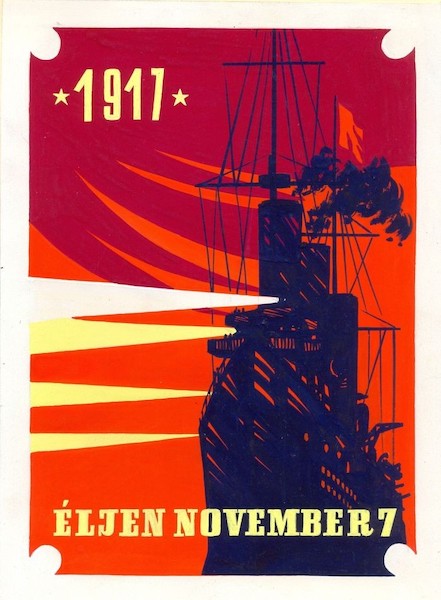
Description:
Very decorative and modern painted poster artwork from the end of the 1950s. It was created by Bertalan Altmann, for remembering the October Revolution of Russia in 1917.
A new period started in Hungarian poster art after the 1956 revolution. The former Rákosi-regime was replaced by the Kádár-system, and the new political situation determined the cultural changes as well. The former great expansion of political propaganda posters of the 1950s came to an end as the new political leadership realized that political issues should be avoided on streets. Along with political propaganda posters commercial posters also disappeared for a while due to the lack of products and independent clients. On the other hand, the genre of cultural poster had its heyday in the 1960s and 1970s.
Although political matters could not appear on posters of the time, there was an exception: big annual political events, state celebrations and anniversaries. These events could fit in the range of cultural events and posters of them also could function as cultural posters. These annual events generated a separated type of cultural poster design and they also gave a hard task to poster designers. The topic was the same year by year and the iconography had its own recurrent elements: waving flags, emblematic state buildings and political symbols appeared in these posters. It didn’t belong to the fancied duty of poster artists neither, but it was a help in case of a constraint of financial matters.
Compared to the average number of copies of a poster (which was about 400-4000) these posters had a high number of copies, about 10-30 000. The size of the poster was bigger than average and the quality and thickness of the paper used was also better. So this genre was a special type from several aspects.
Bertalan Altmann often created poster artworks for state celebrations and anniversaries. This work was created for the anniversary of the 1917 Russian revolution which was celebrated in every country of the Soviet Union during the Socialist period. The celebration was held on the 7th of November, but the original revolution was in October accourding to the calendar Russia used in the period. As the event was forced to be an international celebration in the Eastern bloc, we can find numerous posters in the subject. Altmann has another piece of it in our collection in similar colours.
This poster artwork is a quite modernist design compared to the fact that the political leadership of the period was fighting against all kinds of modernist visuality. The poster artwork was created one year after the end of the absolutism of Socialist Realism in Hungary. The style was the compulsory aesthetic norm of the Rákosi-era, but still after 1956, and with the change of the political situation too, the aesthetic views of the current political power of Hungary didn’t really change. A new system was initialized in cultural politcs: all kinds of designs were put into three categories: „prohibited”, „tolerated” or „promoted”. Thus new styles could emerge, but the old aesthetic views could be propagated easily.
The posters of annual celebrations could sometimes be exceptions as we can find some examples of them with a more modern design. This poster artwork is a decoratively modern piece with the use of a few, strident colours and expressive portrayal. The central element of the composition is the Aurora cruiser which was one of the three Pallada-class warships of Russia and it also became one of the symbols of the October Revolution of Russia from 1917 as one of the first incidents of it took place on it.
„During World War I Aurora operated in the Baltic Sea performing patrols and shore bombardment tasks. In 1915, her armament was changed to fourteen 152 mm (6 in) guns. At the end of 1916, she was moved to Petrograd (the renamed St. Petersburg) for a major repair. The city was brimming with revolutionary ferment and part of her crew joined the 1917 February Revolution. A revolutionary committee was created on the ship, with Aleksandr Belyshev elected as captain. Most of the crew joined the Bolsheviks, who were preparing for a Communist revolution.
At 9.45 p.m on 25 October 1917 (O.S.) a blank shot from her forecastle gun signaled the start of the assault on the Winter Palace, which was to be the beginning of the October Revolution. In summer 1918, she was relocated to Kronstadt and placed into reserve.”
(source: en.wikipedia.org)
The dark blue image of the warship appears in front of the colourful background in an expressively painted composition. Although this poster artwork was created for propaganda reasons in the end of the 1950s, it represented a fresher style in the poster design of the period.











